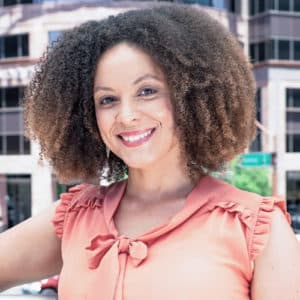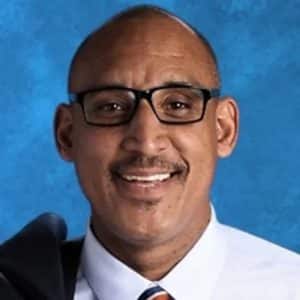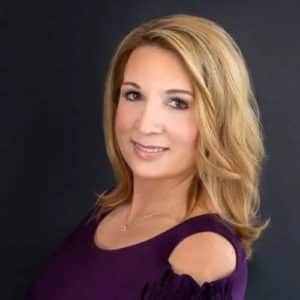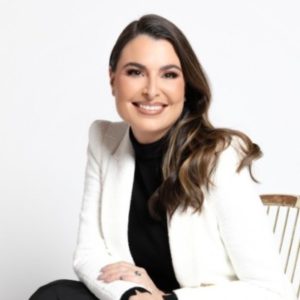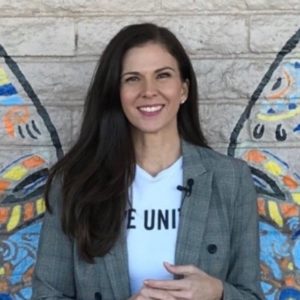
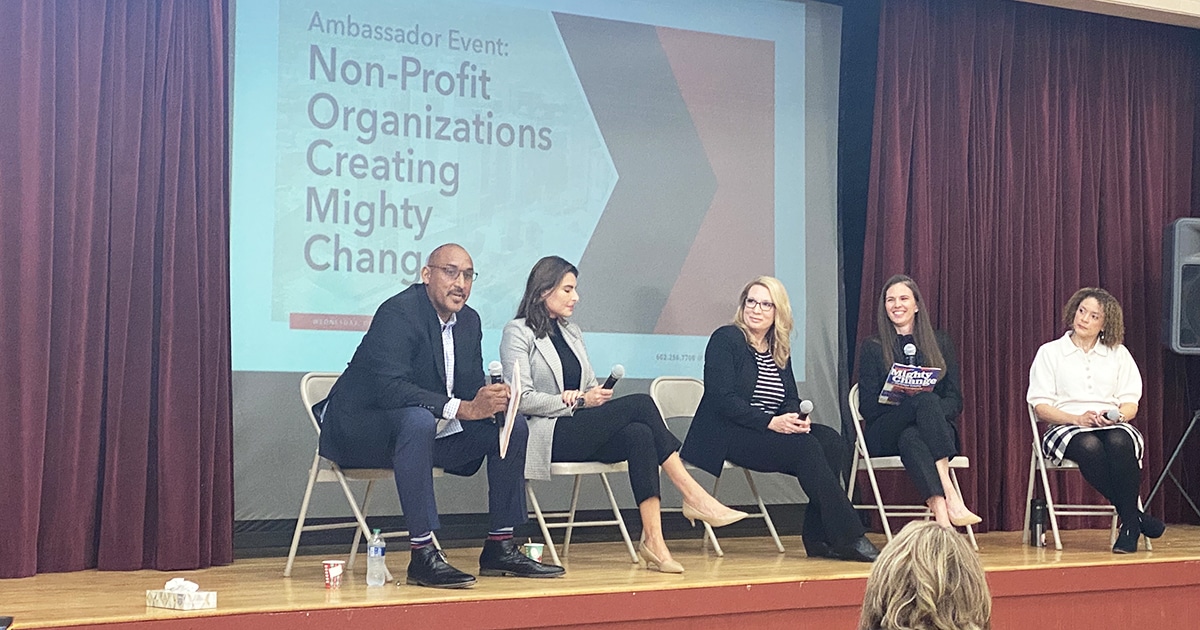
Certified Ambassador Event: Non-Profit Organizations Creating Mighty Change
Published: 12/19/2022
VSUW community plan addresses health, housing, education & workforce development
When the pandemic forced education to go remote, Academia del Pueblo in Phoenix had two major priorities: keeping their students fed and keeping their students learning.
The K-8 school’s partnership with Valley of the Sun United Way (VSUW) addressed shortcomings found in the system — not only when students learned from home, but as they jumped back into an unfamiliar classroom environment surrounded by peers.
In early December, GPEC and a group of Certified Ambassadors toured Academia del Pueblo to learn about the impact of VSUW and its Mighty Change 2026 (MC2026) program, an initiative to address declines in health, housing and homelessness, education, and workforce development coming out of the pandemic. As part of the event, a panel of nonprofit leaders discussed their work and mission. Speakers included:
- Melissa Boydston, Senior Vice President of Community Development and Engagement, Valley of the Sun United Way (Moderator)
- Sam Jackson, Director Community Development in Housing & Homelessness, Valley of the Sun United Way
- Frank Lomeli, School Principal, Academia del Pueblo School
- Kristen Polin, CEO, notMYkid, Inc.
- Vanessa Ruiz, Deputy Vice President, Educational Outreach and Student Services at Arizona State University
The data: COVID-19’s impact on metrics
Studies conducted by VSUW ahead of the MC2026 launch in 2021 showed worsening rates in several different factors for students. Food insecurity increased from 12% to 13%, while the rate of uninsured people rose from 12% to 15%. The estimated count of people experiencing homelessness in Greater Phoenix increased from 7,000 to 9,000.
Education and workforce development numbers decreased, with third grade reading proficiency dropping from 46% to 37%. Attainment of jobs that pay living wages did not align with the increase of higher-paid employment, as the rate of higher-paid employment increased from 59% to 66% but the rate of attainment of living-wage jobs decreased from 59% to 49%.
“Pretty drastic change there in just that small amount of time, so we wanted to make sure that when we were bringing the folks together to really kind of tackle these social, complex issues, that we were doing so in a way that was relevant to our economic landscape,” Boydston said.
VSUW set goals and created partnerships to address key areas in health and educational attainment.
Social impacts at school
Lomeli and Academia del Pueblo foresaw an academic decline when schools closed their doors, but they were taken aback by the lack of development of social skills for young students. After spending so much time learning over Zoom, students had forgotten — or, for the youngest students, never learned — how to effectively handle conflict. There were more fights, more outbursts and more arguments.
One way the school combats this is by starting the day with positive messaging. This isn’t solely to improve kids’ moods or build their self-confidence with compliments of new hairstyles or shoes or little rock-paper-scissors games, but to help teachers evaluate which kids might need extra attention in the coming hours.
“There’s intention in that, because we’re trying to identify who might be having a bad day and who might need extra love that day,” Lomeli said. “We’re flagging students right off the bat when they come onto campus.”
The school also prioritized its breakfast program. The meal not only ensured that students were well-fed in the morning, but it created a more tranquil environment to start the day compared to recess and horseplay first thing in the morning. Participation in the breakfast program increased by 33%.
Academia del Pueblo also compared afterschool program attendance with academic advances. It found that students who attended 30 or more days of programming experienced gains in test scores and declines in disciplinary issues.
“Focusing on educating the whole child is extremely critical. Above and beyond just reading, writing, math and science, how are we helping this child and this family so that they can learn,” Lomeli said. “You can’t learn when you’re hungry and it’s 8:40 and you’re trying to understand a math lesson and your stomach’s growling.”
MC2026 wants to increase third grade reading proficiency by 25% and engagement in education and employment opportunities by 38%.
Mental health
Prior to COVID-19, notMYkid focused primarily on prevention and educational programs for parents and teachers working with about 250 schools. When the classroom doors shut and the number of phone calls from students struggling with mental health increased drastically, programming expanded into a larger range of behavioral health support for youth.
“Bullying and conflict is our No. 1 issue that we’re dealing with with kids, but at root of that is a lot of depression (and) loneliness,” Polin said.
The Elementary and Secondary School Emergency Relief (ESSER) Fund from the Department of Education provided the organization money to hire 30 new employees for additional support services. NotMYkid launched peer support services and trained certified peers to provide wrap-around mentoring services to kids who were experiencing too-long wait times from behavioral health services. The partnership with VSUW helped notMYkid navigate the level of care it needed to provide and address long wait times for people who needed immediate assistance.
“The stress that the parents are experiencing, the inflation issues, it’s harder for parents to fill up the pump, buy food, essential items. Those stressors get passed onto kids. They bring that to school. And I think that that’s the emotional result that we’re seeing,” Polin said.
“The solution is teaching coping skills, helping kids to be more mindful, ensuring that every kid also understands that mental health is not a weakness, that it’s OK to ask for help.”
MC2026 is aiming to increase affordable health care access by 100,000 people and decrease food insecurity by 50% over the five years of program operation.
Workforce development
Leverage AZ, a career development initiative run by Arizona State University, has expanded its reach to 66 educational partnerships with public schools across the region. The program works with a range of schools and industries to help students discover a wider variety of careers and connect them with regional leaders. Workforce and talent pool are among the biggest areas of consideration when a company considers expanding to a new region, so efforts such as these help both the individual and the broader economy — instead of importing talent from other states, companies can fulfill workforce needs with local students.
“We don’t want to hear, ‘That’s why we have to bring it from outside,’ that’s unacceptable to us,” Ruiz said. “We have talented, diverse, passionate, capable, ready students right now in our own backyard. Personally, I think they’re the ones who should be taking advantage of these opportunities.”
With VSUW, Leverage AZ helps more students who are not on pathways for four-year universities access certificates and licenses that can help them build their resumes and get on track for future degrees.
MC2026 aims to increase the rate of high-wage job attainment by 33% while increasing the rate of higher-paid employment by an additional 20%.
“Deeper in the pipeline, earlier in the pipeline. I can’t stress that enough. Literally elementary, like second, third grade is where we should be looking at and starting to really expose our young students to what is possible out in the world,” Ruiz said.
Homelessness
One of the key pieces of MC2026 is to cut homelessness in half — from 9,000 people to 4,500 people — over the five-year period. To do so, VSUW is focusing on wrap-around services to tailor to the needs of an individual person rather than a prescriptive formula for general use with the homeless population. This allows the case managers to identify specific needs and build trust with the person.
VSUW is also using these programs to proactively reach out to young people about careers and help get them set up for success earlier.
The program is looking for innovative ways to provide housing and curb homelessness, whether it’s though innovative design or helping to match roommates with separate leases. Housing partner Vitalyst Health Foundation is developing housing near schools to help teachers and staff better afford to live close to where they work.
“One of the things that we don’t really often talk about when we’re talking about homelessness is how close many of the people that we know or work with are to experiencing homelessness,” Jackson said.
Valley of the Sun United Way and its partners are hoping to address this and alleviate struggles that were amplified due to the pandemic. A year into MC2026, the tactics are starting to take shape.
Meet the Panel
Sam Jackson
Director Community Development in Housing & Homelessness
Valley of the Sun United Way
Frank Lomeli
School Principal
Academia del Pueblo School
Kristen Polin
CEO
notMYkid, Inc.
Vanessa Ruiz
Deputy Vice President, Educational Outreach and Student Services
Arizona State University
Melissa Boydston (Moderator)
Senior Vice President of Community Development and Engagement
Valley of the Sun United Way
